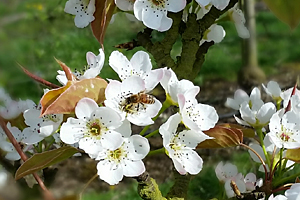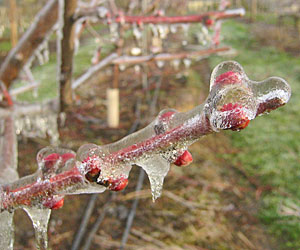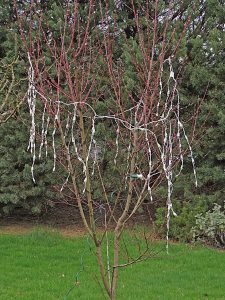 With our mild winter and early spring, most fruit trees are breaking dormancy a bit ahead of normal. This time of year when the forecast is for sunny days and clear nights, it’s possible we’ll get some frost. Should you worry about those fruit buds?
With our mild winter and early spring, most fruit trees are breaking dormancy a bit ahead of normal. This time of year when the forecast is for sunny days and clear nights, it’s possible we’ll get some frost. Should you worry about those fruit buds?
Critical Bud Temperatures
As buds begin to swell, frost damage from cold, clear nights becomes an issue, especially with early blooming fruits such as peaches, plums, cherries, and apricots. Blossoms and developing fruit can be damaged by frost, but it takes a very hard frost to kill all the blossoms on a tree. In peaches, for instance, at full bloom to post bloom, it takes temperatures down to 24°F to kill 90% of the buds. Temperatures of 27°F will only kill about 10% of the buds. However, every night it goes to 27°F, you could lose 10% more of your fruit.
To see a complete picture of critical bud temperatures for various fruit, visit WSU’s Critical Bud Death Temperature Page.

Ice on peach buds
How can you protect your fruit from freeze damage? Below are lined out several ways you can help mitigate the frost risks we face every spring.
- Plant your orchard on the highest part of your property if you have any elevation gain at all. Slopes will tend to have air movement because the cold air settles into the lower areas and the warmer air rises to the upper areas. If the air keeps moving on cold nights your orchard won’t be affected nearly as much because the coldest air tends to settle into the lower sections of a property.
- Planting close to the house or another heated space can buffer the extreme temperatures. Fruit trees suitable for this are espaliered trees and Figs (because of their lack of cold hardiness). You can’t be more the 3-4’ off a wall for this to help.
- Planting trees on the north or east side of a paved area. The paved area will collect a lot of heat during the day only to release it at night.If you have early blooming trees, apricots in particular, you could set several posts and drape an insulating blanket such as Agribon (an agricultural spun polyester product) over the tree for the few nights of frost we worry about in the spring.
 Humidity and water: Some years we have gotten low enough temperatures yet never saw any damage. Some years we have so much moisture in the air that it constantly freezes raising the temperature enough to get through the night. If you have one or two trees you are worried about try setting up a low volume sprinkler overhead. Best results will be if you can turn the stream of water into small particles and get the water several feet in the air. You are not watering the lawn and you don’t have to keep the trees soaked. You just have to get the water into the air. When it freezes, heat is released and raises the air temperature.
Humidity and water: Some years we have gotten low enough temperatures yet never saw any damage. Some years we have so much moisture in the air that it constantly freezes raising the temperature enough to get through the night. If you have one or two trees you are worried about try setting up a low volume sprinkler overhead. Best results will be if you can turn the stream of water into small particles and get the water several feet in the air. You are not watering the lawn and you don’t have to keep the trees soaked. You just have to get the water into the air. When it freezes, heat is released and raises the air temperature.- Hang miniature Christmas lights in the branches of your trees and plug them into a thermal switch. The lights come on at 35°F and stay on until the temperature goes back above 40°F. LED lights don’t work here, as you need the lights to give off a little heat (and add a festive touch to your orchard!)

